
Plum tree, Mirabelle plum tree: planting, pruning, harvesting
Contents
Plum tree in a nutshell
- Plum trees are among the least demanding and most rewarding fruit trees
- In flower early in spring, plum trees produce, depending on varieties, quetsches (or Damson plums), mirabelle plums or greengages with sweet, fragrant flesh
- Harvest takes place from mid-June to mid-September
- Easy to grow, plum trees thrive in any light, fertile, non-calcareous soil
- Can be planted in garden or orchard
A word from our expert
Plum tree (Prunus Domestica) is one of the most widespread fruit trees in our gardens. Damson plum, Greengage plum or mirabelle plum, Prunus Domestica includes different types of plum trees to choose according to your preferences and your region. All produce from June to September fruits of varying sizes, yellow, green or red with sweet, fragrant melting flesh; plums can be enjoyed fresh or dried (prunes), in pastries, jams, compotes or even distilled into eau-de-vie.
A plum tree in flower is always a delight early in spring and, although its early flowering is sensitive to spring frosts, frost rarely jeopardises harvests. Some plum varieties show increased resistance to disease.
Fully hardy, the plum tree grows in sun, in light, calcareous soil that is cool but not excessively wet.
Undemanding once established, simply water it when dry and prune it if necessary to enjoy bountiful plum harvests!
How to plant a plum tree? What planting distance should be respected? Discover our tips to grow this rewarding fruit tree!
Description and botany
Botanical data
- Latin name Prunus domestica
- Family Rosaceae
- Common name Plum tree
- Flowering March-April
- Height 2 to 8 m
- Exposure Sun
- Soil type Neutral to acidic
- Hardiness -15°C
Plum tree or Prunus domestica is a fruit tree of the family Rosaceae, as are apricot, almond and peach. It originates from Syria where it sometimes grows up to 1,000 m altitude. The genus Prunus contains about 400 species. Plum trees are classified into several groups all derived from Prunus domestica. Each of these groups in turn comprises numerous varieties:
- Reine-Claude types that produce round fruits that are yellow, green or purple depending on variety, with very juicy, sweet greenish flesh. This is the most common table plum
- Quetsches or Damson plums that are elongated ovoid in shape, purple or blue-black with a pruinose epidermis and a firm, not very juicy but very sweet flesh. Ideal for making prunes.
- Mirabelles, small round plums of golden-yellow, orange or flushed red colour, with sweet, highly fragrant flesh, much appreciated in tarts, cakes and for distilling eau-de-vie
- Prune d’Ente, used to make the famous Agen prunes
On a taproot with running roots, often producing suckers, the plum tree forms an upright tree averaging 3 to 8 m in height at maturity with an open, rounded or naturally spreading habit. The brown-black bark is slightly fissured. It lives on average between 30 and 50 years.

Prunus Myrobalana – illustration by P.J. Redouté
The smooth, greyish juvenile shoots, bearing woody buds along their length, carry deciduous foliage. Plum branches become quite brittle under the weight of fruit. Leaves obovate to oblong, petiolate, measure 11 to 16 cm long, with crenate margins finely dentate. Green in colour, they are glabrous or slightly villous on the underside. They are sometimes so prominently veined that they appear puckered. In some plums leaves turn yellow in autumn before falling.
Early and particularly abundant flowering precedes the foliage and occurs in March–April depending on region. First flowers open just before leaf emergence on shoots of the previous year. For about three weeks, before cherry trees flower, the plum tree is then covered with small white flowers gathered in umbels of 2 to 3 flowers that appear on last year’s shoots. Typical of Rosaceae, they are cup-shaped and composed of 5 sepals and 5 pedunculate petals gathered in a pubescent calyx. They display numerous protruding stamens. Some are self-fertile (‘Mirabelle de Nancy’, ‘Quetsche d’Alsace’) or partially self-fertile, but most set better with cross-pollination if another Prunus flowering at the same time is nearby. Expect first harvest generally 2 to 3 years after planting.
Flowers pollinated by bees develop into fruits, plums (quetsches, mirabelles or Reine-Claude) which are round or ovoid depending on variety and ripen from July to September. The epidermis is thin, colours varying from purplish-red, bright red, red-violet on a yellow ground, canary yellow tinged with pink, golden yellow or green. It is glabrous but most often covered with a whitish waxy bloom — the pruine — which disappears to the touch. Fruit size varies from about 3 to 5.5 cm in diameter. These clusters enclose firm green-yellow, yellow or deep-red flesh, more or less juicy, highly fragrant, developing delicious aromas of cinnamon, honey or even peach.
Each drupe contains a round or flattened stone, free or attached to the flesh, enclosing an almond that is generally bitter.
With excellent hardiness, the plum tree can be planted throughout France. Undemanding, it grows in sunny positions in any rich, light and deep soil, but without excess moisture or calcareous content.

Some plum trees: Reine-Claude, quetsches and mirabelles
Spread by Greeks and Romans who already cultivated it, plum tree spread in Antiquity around the Mediterranean. By the Renaissance, plums were among the most prized fruits. France remains one of the largest producers of plums; mirabelle and quetsche are grown in the north-east (Alsace and Lorraine: ‘Mirabelles de Nancy’ and ‘Mirabelle de Metz’, ‘Quetsche d’Alsace’), and in the south-west for the Agen prune.
Species and varieties of plums
Prunus Domestica is the most common fruit-plum species in our gardens. There are now dozens of plum varieties, most of which are self-fertile, allowing everyone to harvest sweet, fragrant fruit from mid‑June for early plums through to mid‑September for late plums. Our tips will help you choose the plum tree best suited to your garden or even your terrace.
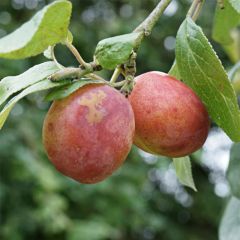
Prunus domestica Victoria - Common plum
- Flowering time April
- Height at maturity 3 m
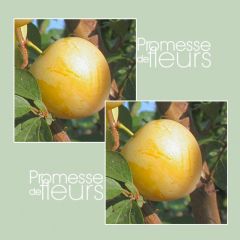
Prunus domestica Golden Japan - Common plum
- Flowering time April
- Height at maturity 7 m
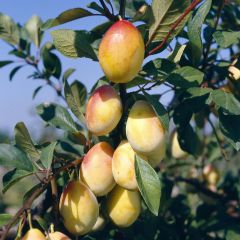
Prunus domestica Thames Cross - Common plum
- Flowering time April
- Height at maturity 7 m
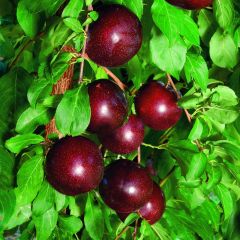
Crimson Glo Plum Tree
- Flowering time May
- Height at maturity 6 m

Prunus domestica Quetsche d'Alsace - Common plum
- Flowering time May
- Height at maturity 6 m

Prunus domestica Stanley - Common plum
- Flowering time April, May
- Height at maturity 8 m
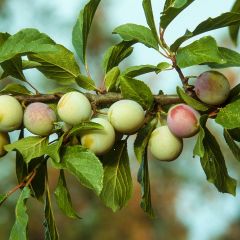
Prunus domestica Reine Claude d'Oullins - Common plum
- Flowering time April
- Height at maturity 8 m

Prunus domestica Reine Claude Dorée - Common plum
- Flowering time May
- Height at maturity 8 m

Prunus Mirabelle de Metz - plum
- Flowering time April
- Height at maturity 5 m
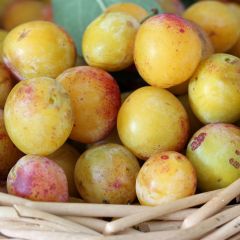
Prunus Mirabelle de Nancy Plum Tree
- Flowering time April, May
- Height at maturity 6 m
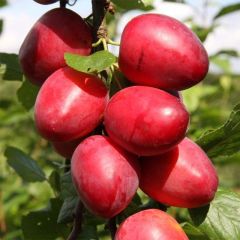
Prunus domestica Mirabelle Ruby - Common plum
- Flowering time April, May
- Height at maturity 3 m
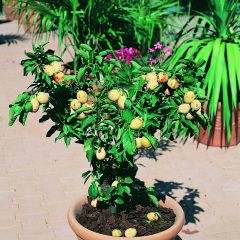
Prunus domestica Goldust - Common plum
- Flowering time May
- Height at maturity 1,50 m
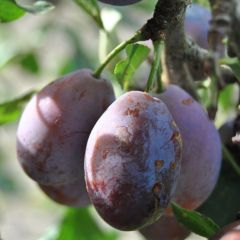
Prunus domestica Prune d'Ente - Common plum
- Flowering time May
- Height at maturity 6 m
→ Find more old and local varieties in our article : “Ancient and local plum varieties: a sustainable, flavourful choice“.
Discover other Plum Trees
View all →Available in 1 sizes
Available in 0 sizes
Available in 0 sizes
Available in 0 sizes
Available in 1 sizes
Available in 2 sizes
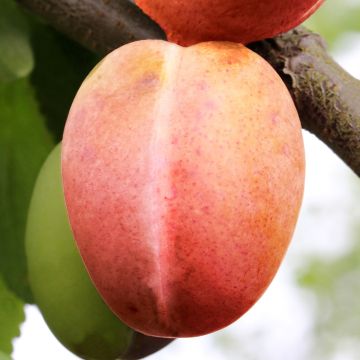
Available in 1 sizes
Available in 1 sizes
Available in 2 sizes
Planting plum trees
Where to plant?
Perfectly hardy, plum trees tolerate temperatures below -15°C and can be grown up to 1,000 metres altitude.
Grown under good conditions, one of easiest fruit trees to grow, being as generous as hardy. Plum trees flower early in spring and are therefore exposed to frosts, although frost rarely compromises plum harvests. Avoid locations too exposed to north and east winds in coldest regions.
To produce good fruit, plum trees appreciate warmth and sunny positions sheltered from strong winds (branches are very brittle).
Vigorous tree suited to all soils, although preferring rich, cool, deep and well-drained soil with slight acidity, without stagnant water or excessive lime.
Only truly at risk in waterlogged ground.
Plum trees are grown only as free-standing forms, so-called open-grown. With white flowering, they bring a touch of freshness in spring to both natural gardens and orchards.
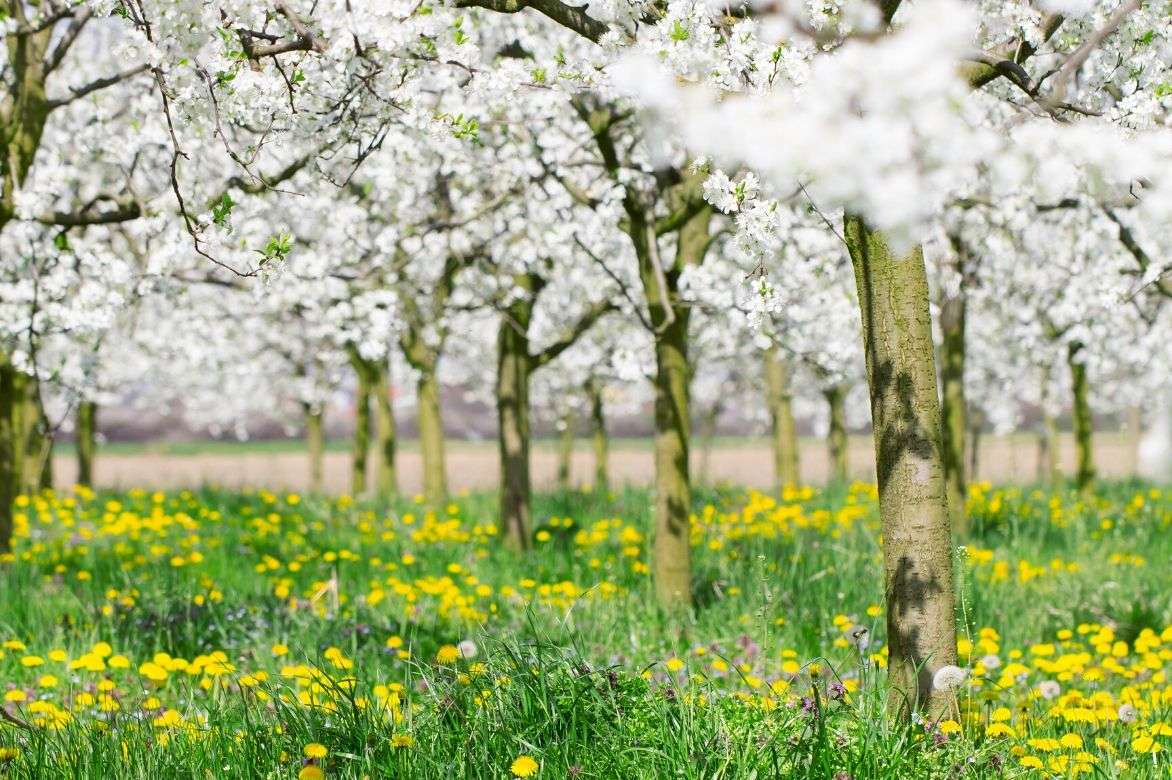
Plum trees in a natural orchard
When to plant?
Planting of plum trees is carried out from November to March during dormancy, outside frost periods. Container-grown trees can be planted all year provided soil is neither frozen nor waterlogged.
How to plant?
In open ground
You can plant plum trees in groups of 3 or 5, spacing plants 6 to 7 m apart.
- prepare ground well;
- dig a wide planting hole at least three times rootball volume (80 x 80 cm);
- ensure drainage with some gravel;
- place tree in hole and install stake without tightening ties too much;
- backfill, firming gradually with garden soil enriched with potting compost, well-rotted compost and 2 or 3 handfuls of ground horn, without burying graft union (leave graft point 10 cm above soil);
- make a basin around base and water generously and regularly to help plum tree establish.
Planting a plum tree in a pot
Some plum trees are suited to planting in large pots (dwarf plum tree ‘Goldust® courod’) ideal for balconies, terraces and small gardens. Remember drainage with a thick layer of gravel at pot base. Plant in soil enriched with compost. Water copiously and regularly. Stake not necessary.
Caring for and pruning plum trees
After planting, for first three years water regularly, as soil should remain cool throughout summer. It does not like overly dry soil. If water is lacking, fruit may drop prematurely. After 2 or 3 years, it will cope better with a short period of drought. Mulch base of your plum tree during first years with dry plant material (bark, fallen leaves, straw…) to help retain coolness in summer.
If necessary, thin fruit.
Ripe plums attract wasps: pick up fallen fruit.
Remove suckers that have grown at base of tree if needed, but hoe with care, as roots are shallow.
In autumn or spring, apply manure or fertiliser for fruit trees.
When and how to prune plum tree?
Plum tree can be left untrained or formed as bush, half-standard or standard. As with all fruit trees, pruning is done in two stages. Be sure to coat pruning wounds with wound-sealing paste.
1) Formative pruning
Formative pruning in young trees is used to shape tree framework and is carried out during the 3 years following planting, before plum tree becomes productive. Prune in winter, outside frost periods, with saw or pruning shear, so as to obtain 4 to 5 scaffold branches oriented outwards.
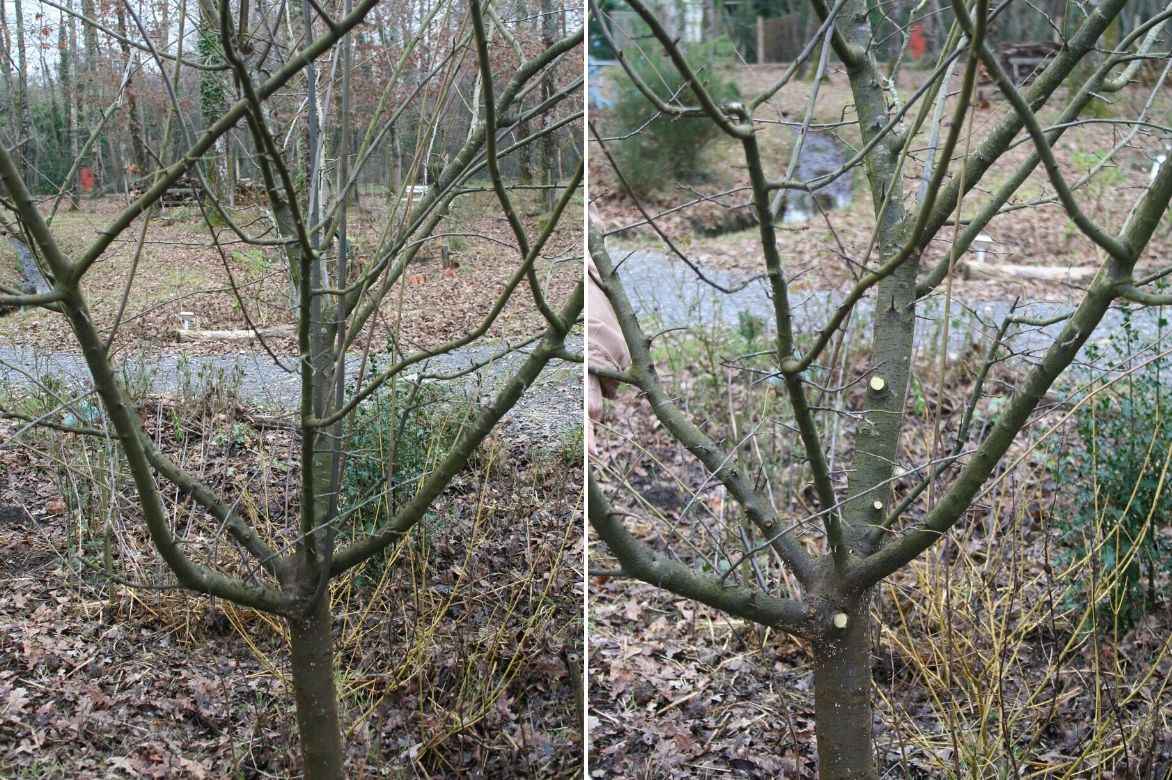
Fruit pruning of a plum tree
2) Fruiting pruning
Then, as soon as your plum tree starts producing fruit, prune every 3 to 5 years at start of autumn (after leaf fall). This pruning helps maintain a balanced habit and encourages good fruit production. Prune with pruning shear or saw above a bud facing outwards of the branches.
- remove suckers that develop on trunk;
- remove dead or broken wood;
- remove branches that cross and trailing branches;
- cut twigs and some inner branches about 25–30 cm from trunk to thin centre of tree and allow sun and air to circulate.
→ Find out more about pruning plum tree with Pascale’s tips in our advice sheet!
Plum tree diseases
Like many fruit trees in its family, plum trees can be susceptible to numerous fungal diseases and pest attacks.
The rust is a fungal disease favoured by warm, humid conditions and is quite common on plum trees. It leaves orange or brown pustules on the fruit and causes necrosis and a reduction in fruit production: treat the tree preventively in spring with sprays of Bordeaux mixture or spray sulphur. Repeat three weeks later.
To prevent the appearance of powdery mildew and brown rot (mummification of the fruit) do the same using Bordeaux mixture, horsetail manure or nettle manure at the beginning of spring and in autumn. Repeat the operation once or twice at 15-day intervals.
Bacterial canker is a fairly common disease on fruit trees: it is recognised by brown spots on the trunk and by deformities of the bark it causes. As a preventive measure, you can treat the tree with Bordeaux mixture in autumn. Any branch that is too badly affected should be cut off and burned. Follow our advice to combat canker.
Sharka virus is an incurable disease transmitted by aphids that affects stone fruit and causes discoloured rings on leaves and shoots. Fruits then become misshapen and unfit for consumption: uproot and burn affected trees, as risk of disease spread is high.
The codling moth is a moth that attacks all plum varieties: it lays its eggs in the fruit flesh, producing larvae that bore galleries through the plum. To prevent them attacking your fruit, discover our advice to combat their establishment.
To avoid appearance or spread of fungi: seal wounds well with a healing mastic during pruning and collect fallen fruit from the soil.
Read also our article on Gummosis in stone fruit trees.
Plum tree propagation
Plum tree is propagated by grafting (graft by shield budding with a dormant eye or inlay graft), by separation of suckers in spring or by sowing for mirabelle plum. Grafting is a fairly specialised technique that requires some skill. We advise reserving it for professionals.
Dividing plum tree
You can remove the suckers that develop around the base of your Prunus, but they will only flower several years after planting.
- Dig around the sucker, then lift it;
- With pruning shear, cut the roots that connect it to the mother plant;
- Plant the sucker in a bucket and transplant it into the ground in autumn or the following spring.
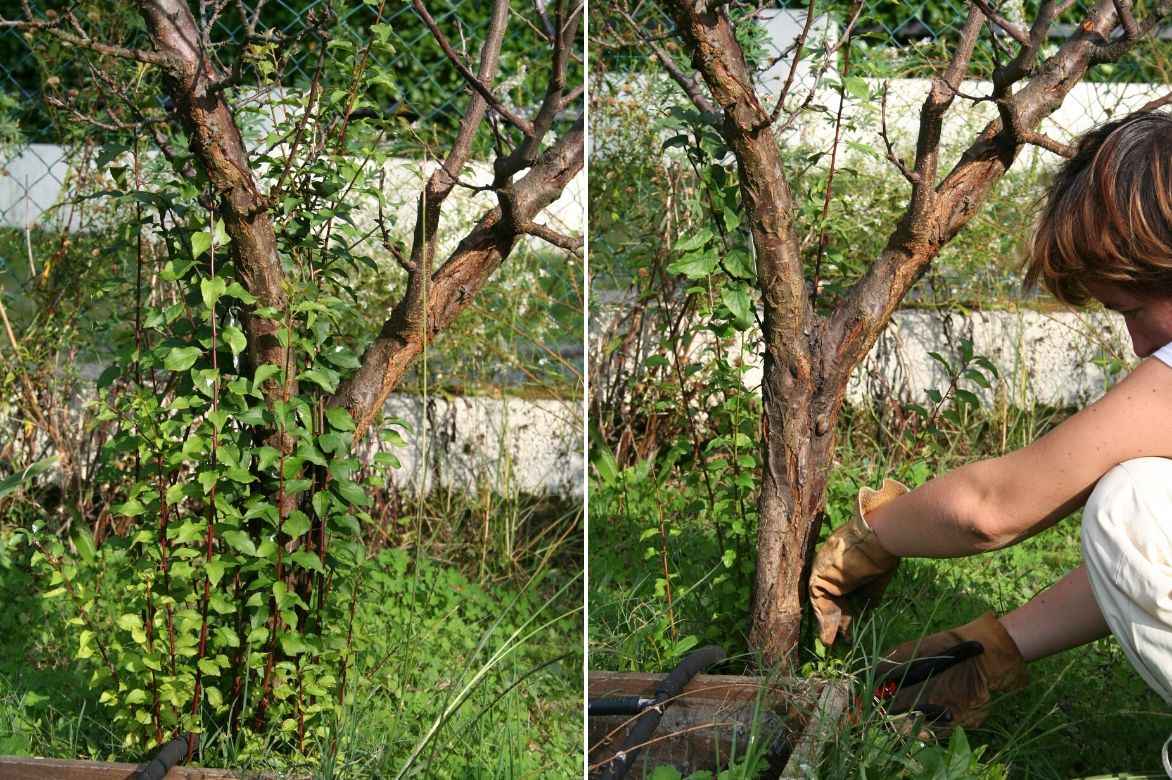
Removal of suckers from a plum tree
How to plant a plum stone?
At the end of summer, plant a plum stone in well-prepared soil and let nature and time do the rest! You can also stratify the stones in a non-perforated container, alternating layers of stones with layers of potting soil and sand. Store in an airy, unheated place and water to keep constantly moist until the following spring. Between February and March, plant the germinated stones in buckets so they can root, then plant out in the garden in autumn.
When and how to harvest plums?
Plums, damsons, mirabelles or greengages reach ripeness from late June for early plums to mid-September for late plums. Fruits are harvested when ripe, once they are easy to detach from the tree. Harvest lasts around two weeks. You can use a picking pole, a stepladder or an A-frame ladder to pick your plums.
How to store and use your plums?
Plums are eaten straight from the tree and do not keep for more than three days at room temperature. However, they can be frozen once washed, dried and pitted, or preserved as jam or in syrup. You can also dry quetsches or plums intended for prunes in the sun during summer, pitted and hung as garlands on a string, or in the oven.
How to use plums?
Plums are delicious eaten raw or mixed into a fruit salad, but also in desserts, in clafoutis, incorporated into cakes, crumbles or tarts, or served with white meats, for example in tagines. They are most often made into jam and compote but also distilled into eau-de-vie, particularly for mirabelle. Prune d’Ente produces excellent prunes when dried and is also suitable for juice.
⇒ Discover how to make your own prunes at home
Plums are fairly low in calories and packed with vitamins B and E, antioxidants and minerals and trace elements, notably potassium, iron and magnesium. They are well known to help promote kidney elimination and to play a regulatory role in bowel transit.
Good companion plants for plum trees
In the garden as well as in the orchard, some combinations prove to be valuable allies in combating pests and/or improving harvests. Some are indispensable for plum trees. Common tansy attracts a multitude of insects such as ladybirds; planted close to your plum tree, it will help keep pests at bay. A few raspberry plants near the plum make good companions as they provide excellent refugia for beneficial insects; they will attack aphids, for example, which spread the sharka (plum pox) virus.
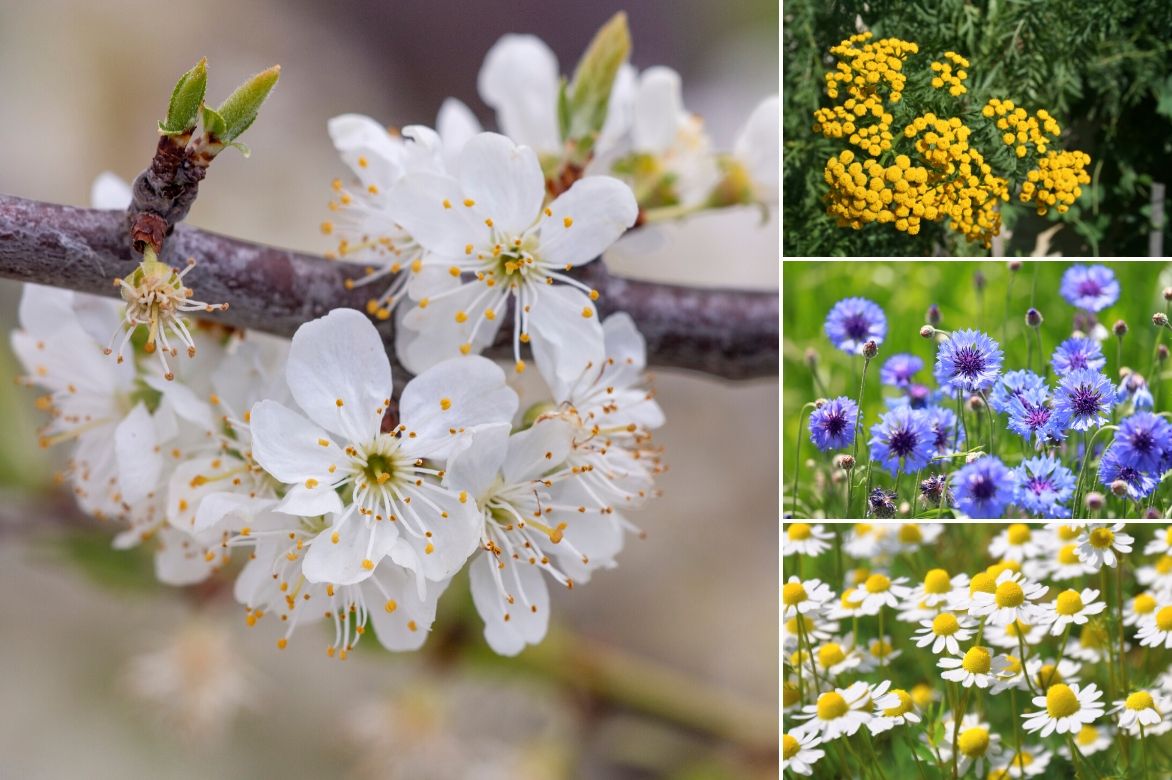
An example of an association with tansy, cornflowers and chamomile
Chamomile and cornflower will also attract predatory insects that feed on aphids.
Useful resources
-
- All tips to grow, protect and maintain your fruit trees are on our blog
- Sow a flowering meadow at the foot of your fruit trees and nature will repay you
- Discover our selection of best plum tree varieties
- Advice sheet: Diseases and parasitic pests of plum trees
- Buyer’s guide: Plum tree: how to choose the right variety?
- Discover the hybridization between plum and apricot: the pluot!
- Discover the hybridization between plum and apricot: the pluot! and best pluot varieties, the apricot-plum
- Subscribe!
- Contents
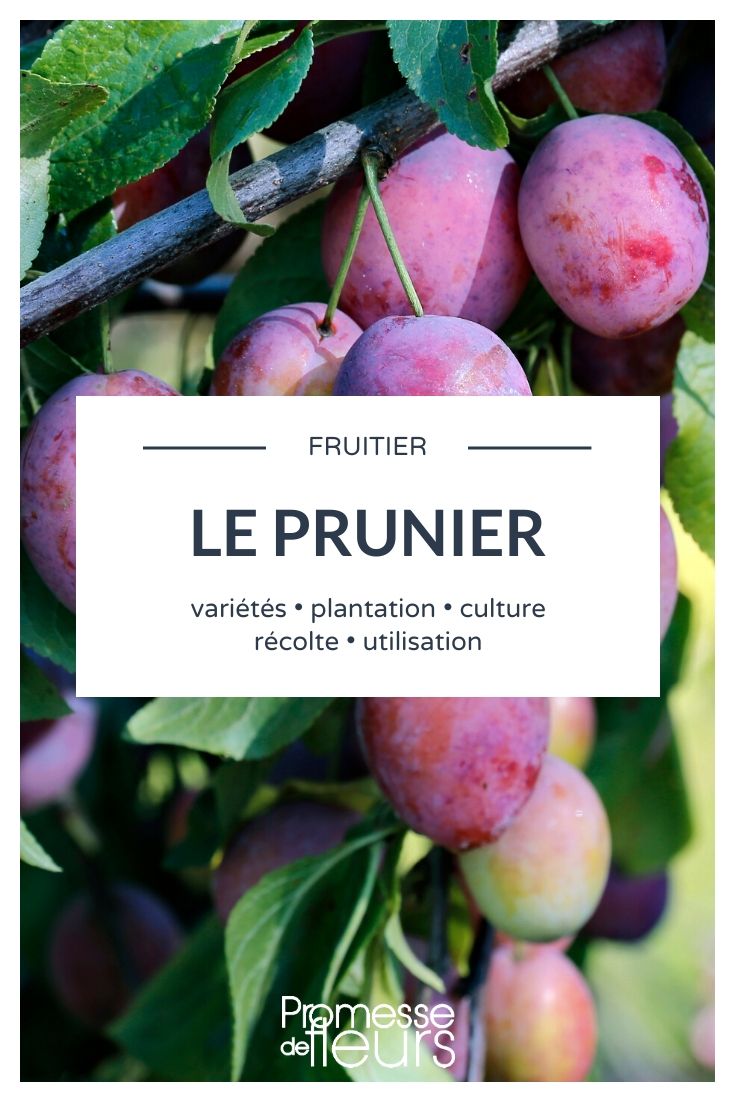































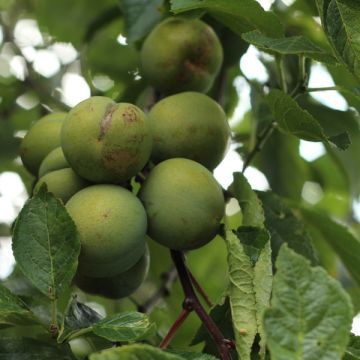
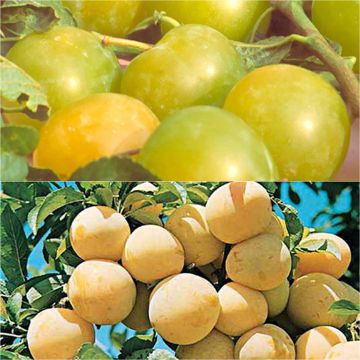
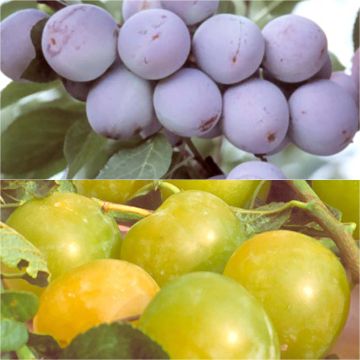
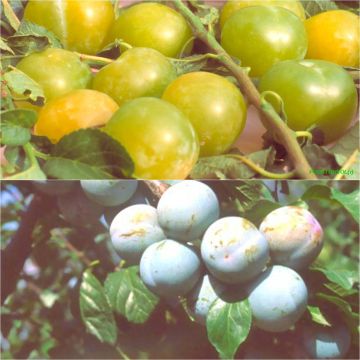
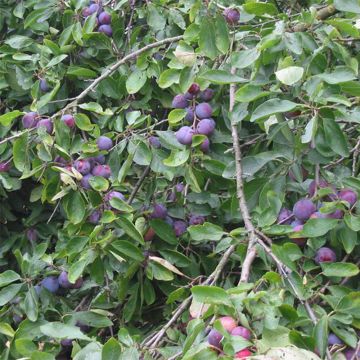


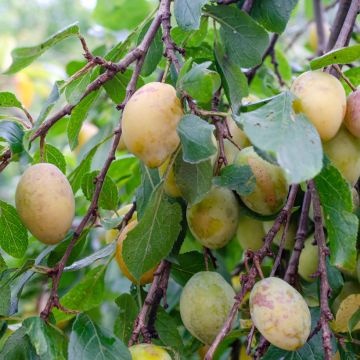
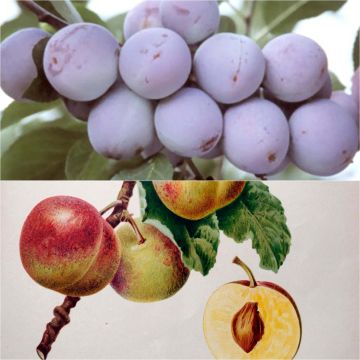
Comments